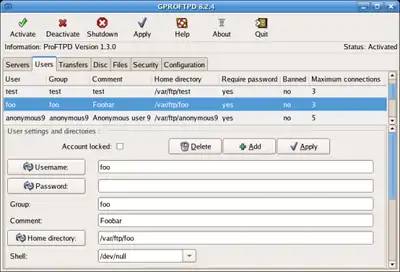GAdmintools
GAdmintools are a collection of computer programs, specifically application software, which provide a graphical user interface for specific server services running on the Linux operating system.[1][2]
 The GAdmin-ProFTPD 8.2.4 user tab | |
| Original author(s) | Magnus Loef |
|---|---|
| Developer(s) | Magnus Loef |
| Stable release | diverse
|
| Operating system | Linux |
| Platform | GTK+ |
| Available in | English |
| Type | Operating system setup and configuration tool |
| License | GNU General Public License version "3 or later" |
| Website | dalalven |
With the help of GAdmintools, the user can easily configure, administer and monitor those server services in real time, in a user-friendly manner, that would otherwise be challenging for the average user.[3][4]
Availability
The GAdmintools are - as a whole or as parts - included in the repositories of many major GNU/Linux distributions, such as Debian,[5] Ubuntu,[6] Linux Mint,[7] Puppy Linux,[8] Frugalware Linux[9] and others.[1] If a distribution is used which does not provide a distribution-ready package, it is possible to install by downloading the source code and running a simple ./Autoinstall procedure.[10]
Components of the GAdmintools collection
- GAdmin-DHCPD: Front end for the DHCP server DHCPD
- GAdmin-SAMBA: Front end for the file and print server Samba
- GAdmin-ProFTPD: Front end for the FTP-Server ProFTPD
- GAdmin-BIND: Front end for the DNS-Server BIND
- GAdmin-HTTPD: Front end for the Web server Apache
- GAdmin-SQUID: Front end for the HTTP-Proxy server Squid
- GAdmin-RSYNC: Front end for the File-Backup- and File-Synchronization-Server rsync, as well as for its client
- GAdmin-OpenVPN-Client: Front end for the client of OpenVPN
- GAdmin-OpenVPN-Server: Front end for the server of OpenVPN
- GAdmin-Sendmail: Front end for Sendmail
Remote administration
GAdmintools are not only capable of administering server services running on the local machine, but also to connect to server services running on remote machines. This is done by creating a SSH tunnel and then connect with GAdmintools to the server service running on the remote machine through this secure tunnel.[11] This way it is possible to remotely administer machines which are running without graphical desktop or even headless.
References
- Admin Magazin "Updates für Gadmin-Tools" (german)
- Tuxradar: "100 open source gems - part 1"
- ghacks.net: "Set up a Linux VPN Server with Gadmin-VPN-Server"
- ghacks.net: "Create rsync backups easily with the help of Gadmin-rsync"
- Debian package search: "gadmin"
- Ubuntu package search: "gadmin"
- Linux Mint package gadmin-tools
- Puppy Linux package search "gadmin"
- Frugalware package search "gadmin"
- IBM developerWorks: The rsync family
- Techrepublic: Review: "Gadmintools suite of configuration utilities"
External links
- https://web.archive.org/web/20160609143356/http://dalalven.dtdns.net/linux/gadmintools-webpage/ Official web site of the project
- http://freecode.com/users/magnusswe user page of the developer if GAdmintools on freecode.com with links to all GAdmintools components